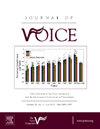Immediate Effects of Mindfulness Meditation on the Voice
IF 2.5
4区 医学
Q1 AUDIOLOGY & SPEECH-LANGUAGE PATHOLOGY
引用次数: 0
Abstract
Objectives
The benefits of mindfulness meditation are well documented. This study evaluated the immediate effects of mindfulness meditation (MM) on the voice and voice user.
Study design
Prospective experimental study.
Methods
Participants: 19 vocally healthy (VH) individuals, and 26 individuals with common voice disorders (CVD; benign lesions and hyperfunctional muscle tension) deemed stimulable for voice therapy. Exclusionary criteria: prior training or regular meditation practice. Participants recorded speech samples before and after a 11.5-minute prerecorded session of MM. Primary outcomes: phonatory aerodynamics and participants’ self-reported experience of voice. Secondary outcomes: self-reported anxiety, vocal acoustics, speech breathing patterns, and auditory-perceptual outcomes. Baseline self-reported measures of voice (Voice Handicap Index-10 - VHI-10), breathing (Dyspnea Index – DI), stress (Perceived Stress Scale - PSS), and trait mindfulness (Cognitive and Mindfulness Scale – Revised, CAMS-R, Five Facet Mindfulness Questionnaire – FFMQ) were compared between groups.
Results
At baseline, CVD had significantly higher VHI-10 (P< 0.001) and DI (P= 0.0014), and lower trait mindfulness (CAMS-R, P= 0.02). No difference between groups for PSS or FFMQ. Changes postMM: decreased CPP for all-voiced sentences for VH (P= 0.003), decreased mean SPL (P= 0.012) on sustained vowel for VH, increased mean phonatory airflow during sustained vowel for CVD (P = 0.012). VH demonstrated a decrease in CPP on the all-voice sentence, and CVD demonstrated an increase, resulting in a significant between group difference (P= 0.013). Participants reported improvements in voice, emotional and physical states. State anxiety decreased for both groups (= < 0.001). No other objective outcomes reached significance.
Conclusions
After a brief MM, participants experienced improvement in physical, emotional, and cognitive states, and in their perceptions of their voice. Results indicate that a brief, single session of MM may be beneficial for some, but not sufficient to override habitual voice and speech patterns. Given the benefits of MM, future work should evaluate MM in a standard voice therapy protocol.
正念冥想对嗓音的直接影响
目的:正念冥想的益处有据可查。本研究评估了正念冥想(MM)对声音和声音使用者的直接影响:研究设计:前瞻性实验研究:方法:参与者:研究设计:前瞻性实验研究。方法:参与者:19 名嗓音健康(VH)者和 26 名患有常见嗓音疾病(CVD;良性病变和功能亢进性肌肉紧张)并被认为可接受嗓音治疗的人。排除标准:之前接受过训练或定期进行冥想练习。主要结果:嗓音空气动力学和参与者自我报告的嗓音体验;次要结果:自我报告的焦虑、声学、语言呼吸模式和听觉感知结果。对基线自我报告的嗓音(嗓音障碍指数-10 - VHI-10)、呼吸(呼吸困难指数 - DI)、压力(感知压力量表 - PSS)和正念特质(认知和正念量表 - 修订版,CAMS-R,五面正念问卷 - FFMQ)进行组间比较:基线时,CVD的VHI-10(P< 0.001)和DI(P= 0.0014)明显较高,而正念(CAMS-R,P= 0.02)较低。PSS 或 FFMQ 组间无差异。MM后的变化:VH全发声句子的CPP下降(P= 0.003),VH持续元音时的平均SPL下降(P= 0.012),CVD持续元音时的平均发音气流增加(P= 0.012)。在全发声句子中,VH 的 CPP 有所下降,而 CVD 有所上升,组间差异显著(P= 0.013)。参与者报告了语音、情绪和身体状态的改善情况。两组的状态焦虑都有所减轻(= < 0.001)。其他客观结果均无显著性:简短的 MM 之后,参与者的身体、情绪和认知状态以及对自己嗓音的感知都有所改善。结果表明,简短的单次嗓音训练可能对某些人有益,但不足以改变习惯性的嗓音和说话模式。鉴于MM的益处,未来的工作应该对标准嗓音治疗方案中的MM进行评估。
本文章由计算机程序翻译,如有差异,请以英文原文为准。
求助全文
约1分钟内获得全文
求助全文
来源期刊

Journal of Voice
医学-耳鼻喉科学
CiteScore
4.00
自引率
13.60%
发文量
395
审稿时长
59 days
期刊介绍:
The Journal of Voice is widely regarded as the world''s premiere journal for voice medicine and research. This peer-reviewed publication is listed in Index Medicus and is indexed by the Institute for Scientific Information. The journal contains articles written by experts throughout the world on all topics in voice sciences, voice medicine and surgery, and speech-language pathologists'' management of voice-related problems. The journal includes clinical articles, clinical research, and laboratory research. Members of the Foundation receive the journal as a benefit of membership.
 求助内容:
求助内容: 应助结果提醒方式:
应助结果提醒方式:


